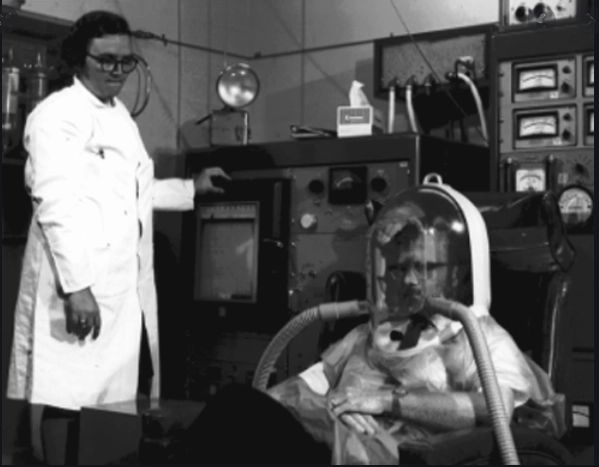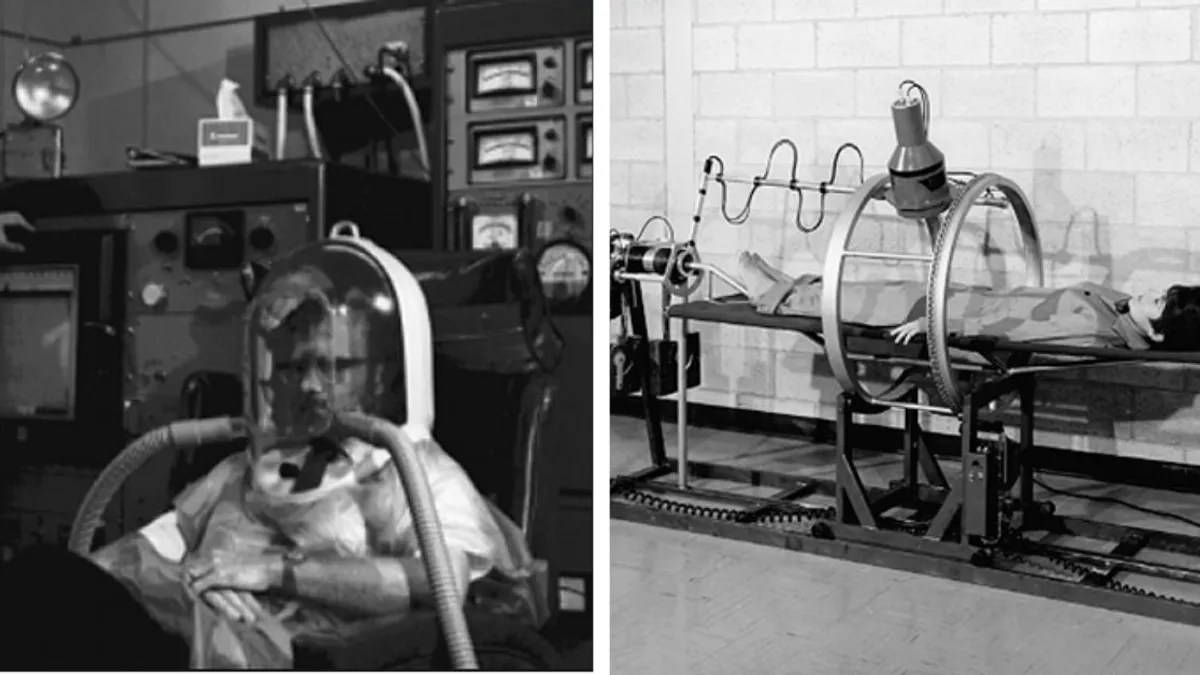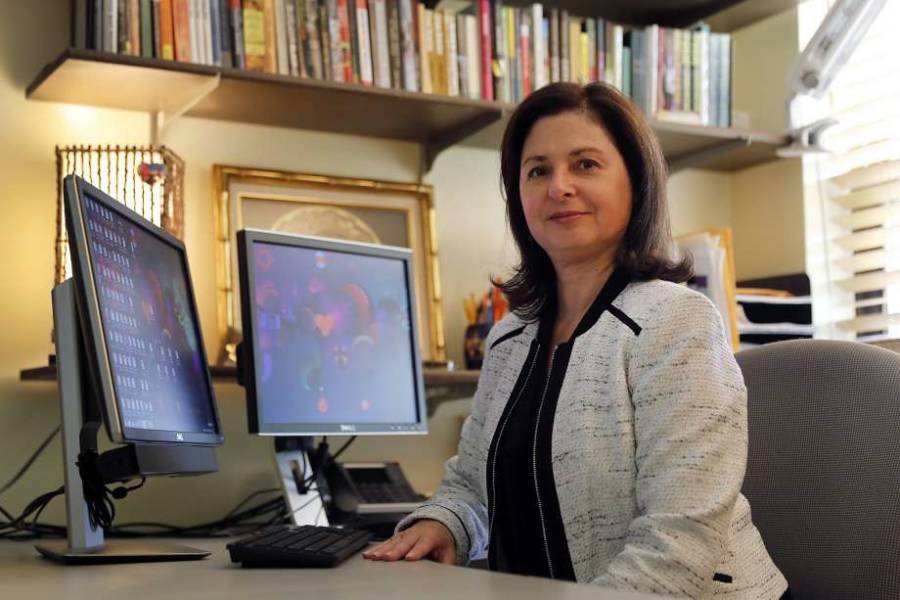Nuclear Guinea Pigs: Radiation Experiments Performed on US Citizens
During the Cold War, the US conducted experiments with radioactive substances on its citizens.
Between April 1945 and July 1947, in experiments performed at hospitals in Rochester, New York, Oak Ridge, Tennessee, Chicago, Illinois, and San Francisco, California, subjects were injected with various types of radioactive substances. Eighteen subjects were injected with plutonium, six with uranium, five with polonium, and at least one with americium.
In 1986, the U.S. House Committee on Energy and Commerce released a report entitled, American Nuclear Guinea Pigs: Three Decades of Radiation Experiments on U.S. Citizens.
Then, in November 1993, journalist Eileen Welsome began a three-part story in the Albuquerque Tribune newspaper that described government experiments that were conducted on Americans during the Cold War. For her effort, Welsome received a Pulitzer Prize in 1994.
Welsome’s reporting led to the creation of the Advisory Committee on Human Radiation Experiments by President Bill Clinton. The committee published its results in 1995. The report described the following instances where Americans were dosed with radioactive substances without their express knowledge or full consent:
- 57 normal adults were fed spheres containing radioactive uranium and manganese at the Los Alamos Scientific Laboratory in the 1960s
- 20 elderly adults were fed radium or thorium at the Massachusetts Institute of Technology during the early 1960s
- 18 terminally ill patients were injected with plutonium in hospitals in Oak Ridge, Tennessee, Rochester, N.Y., Chicago and San Francisco
- 6 emotionally disturbed or homeless patients with normal kidney function were injected with uranium salts at the University of Rochester from 1946 to 1947
- 131 inmates at Oregon and Washington state prisons had their testicles irradiated between 1963 and 1971
- 14 people in Richland, Washington were exposed to tritium during 1951 and 1952, either by breathing, eating, or bathing in it
- 102 people were fed particles containing strontium, barium, or cesium between 1961 and 1963, at the University of Chicago and the Argonne National Laboratory
- 54 patients in a hospital near the Oak Ridge Institute for Nuclear Studies, and who had normal intestinal tracts, were fed lanthanum-140 during the early 1960s
- 12 terminally ill cancer patients at Columbia University and Montefiore Hospital in the late 1950s were injected with radioactive calcium and strontium
- 14 people in 1967 were either injected with or drank radioactive promethium at the Hanford Environmental Health Foundation and Battelle Memorial Institute in Richland, Washington
- 10 people were either injected with radioactive phosphorus or else fed Columbia River fish which were contaminated with radioactive phosphorus in 1963

Experiments on infants and pregnant women
In 1945, researchers at Vanderbilt University gave 829 pregnant women what were described as “vitamin drinks”, but which actually contained radioactive iron. The experiment was to see how fast the radioisotope passed into the women’s placentas.
While the mothers experienced rashes, bruises, anemia, hair and tooth loss, and cancer, at least four of the children who were subsequently born to these women died from cancers, including leukemia.
In 1953, at the University of Iowa, the Atomic Energy Commission began testing the effect of radioactive iodine on newborns and pregnant women. Researchers gave between 100 and 200 microcuries (3.7 to 7.4 MBq) of iodine-131 to pregnant women, to determine whether radioactive iodine crossed the placental barrier.
Another study gave 25 babies who were less than 36-hours-old and who weighed between 5.5 and 8.5 pounds (2.5 to 3.9 kg) iodine-131, either by mouth or injection, then measured the amount of iodine in their thyroid glands.
An AEC study at the University of Nebraska College of Medicine fed iodine-131 to 28 healthy infants through a gastric tube in order to gauge the amount of iodine in the infants’ thyroid glands.
During 1946 and 1947, researchers at the University of Rochester injected uranium-234 and uranium-235 into six people to see how much uranium their kidneys could tolerate before becoming damaged.
In 1949, near the Hanford site in south-central Washington state, the Atomic Energy Commission released iodine-131 and xenon-133 into the atmosphere. It contaminated a 500,000-acre (2,000 sq km) area, which included three small towns.
In 1945, Albert Stevens received the diagnosis of stomach cancer at the U.C. San Francisco Medical Center. Without informing Stevens, a former Manhattan Project doctor, Joseph Gilbert, had Stevens injected with two isotopes of plutonium: Pu-238 and Pu-239.
Prior to experimentation, scientists had assumed that 90% of injected plutonium would be excreted from the body, however, what they found was that 90% of the plutonium remained in patients’ bones for decades.
Stevens, in fact, did not have cancer; however, his accumulated dose of Pu-238 was higher than anyone had received in history, at 64 Sv (6400 rem), despite the fact that he did not develop radiation sickness.
Neither Stevens nor his relatives were told about the plutonium he had received, however, in 1975, when Stevens had died, his cremated remains were surreptitiously acquired by the Argonne National Laboratory Center for Human Radiobiology and the National Human Radiobiology Tissue Repository at Washington State University.
A warm bowl of radiation
In December 1995, a lawsuit was filed against the odd combination of the Quaker Oats company and renowned university, the Massachusetts Institute of Technology (MIT).
In an almost unthinkable experiment, conducted during the 1940s and 1950s, MIT provided radioactive isotopes, which were added to the calcium and iron additives contained in Quaker Oats’ oatmeal cereal.
The oatmeal was then served to 74 children who lived at the Fernald School, a state home for the mentally retarded located in Waltham, Massachusetts. The radioactive “tracers” allowed researchers to track the absorption of the calcium and iron into the children’s bodies.
The entire purpose of the experiment was to give Quaker Oats a leg up in its rivalry with Cream of Wheat cereal. A lawyer representing the children, Michael Mattchen, was quoted in a 1995 Associated Press article as saying, “There was an utter failure to treat these kids with any human decency.”In October 1995, then-president Bill Clinton apologized to the Fernald School, and the president of MIT also apologized on behalf of the school.
U.S. Performed Radiation Experiments On Its Own Citizens, New Book Reveals
Three House Democrats who represent areas where testing occurred have come forward to demand greater government transparency on the issue.
Arecently released book details the experiments the US government undertook, over decades, on their own unknowing citizens to test the effects of radiation.
The San Francisco Chronicle reports that a recently published book by Lisa Martino-Taylor, an associate professor of sociology at St. Louis Community College, reveals the experiments the US government conducted to determine the dangers of radioactivity on its own populace.
In her newest book, Behind the Fog: How the U.S. Cold War Radiological Weapons Program Exposed Innocent Americans, Martino-Taylor details how unsuspecting American citizens were fed, sprayed, or injected with radioactive materials during a series of experiments from the 1940s to the late 1960s.
Using previously unreleased documents, including Army records, that she obtained through the Freedom of Information Act, Martino-Taylor discovered that throughout these decades, researchers worked to develop radiological and “combination weapons,” weapons using radioactive materials along with chemical or biological weapons, by testing them on unknowing Americans.
One example she cites is a 1940s experiment in Nashville, TN wherein 820 impoverished pregnant women were given a mixture that included radioactive iron during their first prenatal visit. These women were given the radioactive material without their knowledge and had their blood, and the blood of their babies, tested by scientists to determine how radioactive exposure during pregnancy effects babies.
Similar tests were also performed in Chicago and San Francisco.
“They targeted the most vulnerable in society in most cases,” Martino-Taylor said. “They targeted children. They targeted pregnant women in Nashville. People who were ill in hospitals. They targeted wards of the state. And they targeted minority populations.”
Martino-Taylor’s newest book was a follow up to her 2012 dissertation, which brought to light the testing of radioactive materials by the government on poor communities in St. Louis in the 1950s and 1960s.
She discovered that in the mid-1950s, the US Army sprayed zinc cadmium sulfide, a fine fluorescent powder, onto impoverished African American neighborhoods in St. Louis, MO from planes and roof-mounted machines. The idea was to simulate how biological and chemical weapons would spread through a city.
Martino-Taylor says she has discovered evidence that radioactive materials were mixed into the chemical payload.
One woman who witnessed this chemical test, Mary Helen Brindell, 73, remembers playing outside on her street when Army planes showered her neighborhood with a fine white substance.
Brindell suffered from breast, thyroid, skin, and uterine cancers throughout her life. Her sister died of a rare esophageal cancer.
“I just want an explanation from the government,” Brindell said. “Why would you do that to people?”
In Behind the Fog, Martino-Taylor details further examples of the US government unknowingly turning their own citizens into guinea pigs in order to test the effects of radiation, continuing well into the 1960s.
In California, throughout the 1950s and 60s, scientists created radiation fields in areas where they knew it would effect unknowing citizens. This includes fields created in UCLA, in a Los Angeles Police Department building, and even in a North Hollywood high school.
The book also describes testing in Berkeley, Chicago, Rochester, NY, and Oak Ridge, TN, involved injecting unknowing patients with the radioactive isotope plutonium-239.
In response to these revelations, three House Democrats who represent areas where testing occurred, William Lacy Clay of Missouri, Brad Sherman of Sherman Oaks, and Jim Cooper of Tennessee, came forward to demand greater government transparency on the issue.
“We are asking for details on the Pentagon’s role, along with any cooperation by research institutions and other organizations,” Chris Carroll, a spokesman for the office of Jim Cooper, said. “These revelations are shocking, disturbing and painful.”
Hopefully, this increased pressure on the military from elected officials and the general public will force them to reveal what exactly happened in these instances.
Despite the shock of elected officials, this is far from the first time that the US government has authorized the use horrifying and deadly experiments on unknowing Americans.
In the 1930s, through to the 1970s, the U.S. Public Health Service conducted a study where they took 399 African American sharecroppers from Macon County, Alabama with syphilis and provided them with bogus medication to track the degeneration of the body under syphilis.
This continued well after the discovery of penicillin as a cure for syphilis, a discovery that the U.S. Public Health Service concealed from the people in their study. Researchers leading the test also prevented any of the men in their study from receiving penicillin.
This study came to be known as the Tuskegee Syphilis Experiment, for the researchers’ collaboration with the Tuskegee University.


